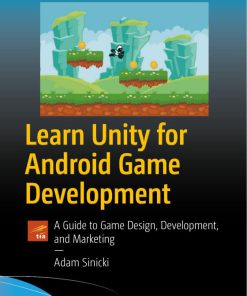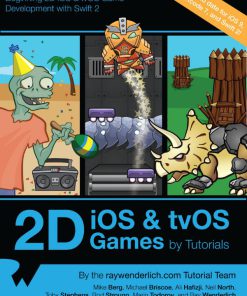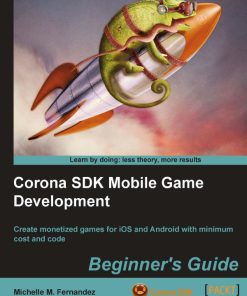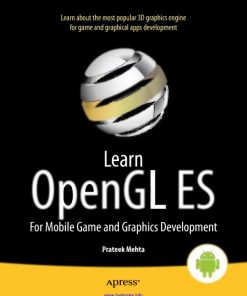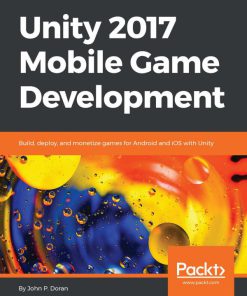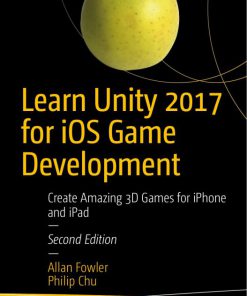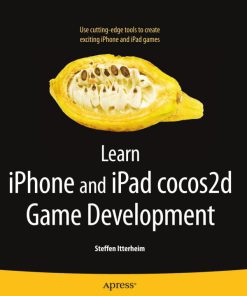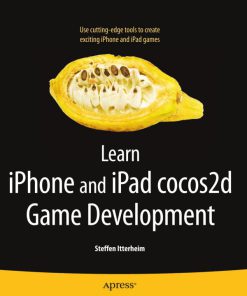(Ebook PDF) Learn SpriteBuilder for iOS Game Development 1st edition by Steffen Itterheim 1484202627 9781484202623 full chapters
$50.00 Original price was: $50.00.$25.00Current price is: $25.00.
Authors:Steffen Itterheim , Series:Gaming [63] , Author sort:Itterheim, Steffen , Ids:9781484202630 , Languages:Languages:eng , Published:Published:Nov 2014 , Publisher:Apress
Learn SpriteBuilder for iOS Game Development 1st edition by Steffen Itterheim – Ebook PDF Instant Download/DeliveryISBN: 1484202627, 9781484202623
Full download Learn SpriteBuilder for iOS Game Development 1st edition after payment.
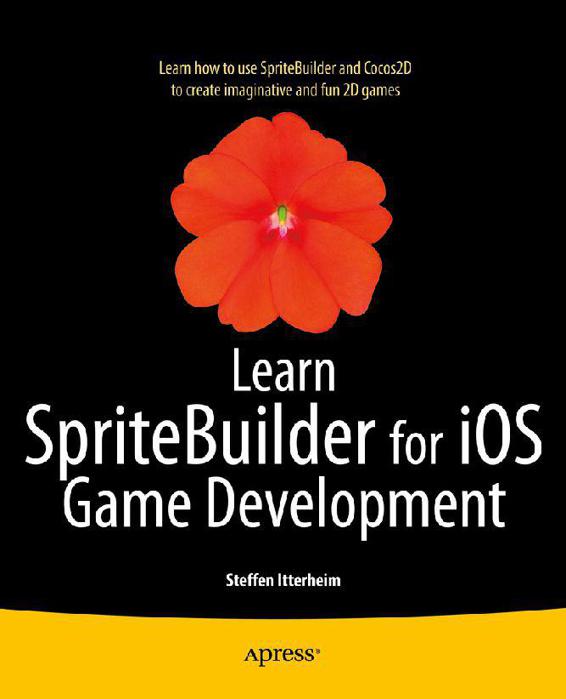
Product details:
ISBN-10 : 1484202627
ISBN-13 : 9781484202623
Author : Steffen Itterheim
SpriteBuilder is the fun and versatile game development environment that is a natural successor to Cocos2D, Cocos3D, and Chipmunk2D. In Learn SpriteBuilder for iOS Game Development, experienced game developer and author Steffen Itterheim shows you how to get the most out of SpriteBuilder to create a full-featured 2D action game that you can use as a basis for your own games. You’ll learn SpriteBuilder best practices, how to incorporate SpriteBuilder into your game development workflow, and how to use the various features of SpriteBuilder, including game physics, scrolling, menus, and playing audio assets. You’ll learn everything from the basics to advanced topics like visual effects, soft-body physics, rendering textured polygons and porting to Android. You’ll be using both SpriteBuilder and the latest version of Cocos2D, version 3. If you have a bit of iOS development experience and you want to learn to create imaginative 2D games, Learn SpriteBuilder for iOS Game Development is exactly the book you need.
Learn SpriteBuilder for iOS Game Development 1st Table of contents:
Part I: Introducing SpriteBuilder and Cocos2D-iphone version 3
Chapter 1: Introduction
What’s in This Book?
Who Is This Book for?
The Absolute Beginner
The Experienced App Developer
The Experienced Cocos2D Game Developer
Requirements
About SpriteBuilder
Why Use SpriteBuilder?
About Cocos2D
About Apportable
About Program Versions
About Xcode Versions
About the Example Projects
Example Projects Mapped to Chapters
About Deployment Targets
Table of Contents
Chapter 1—Introduction
Chapter 2—Laying the Groundwork
Chapter 3—Controlling and Scrolling
Chapter 4—Physics and Collisions
Chapter 5—Timelines and Triggers
Chapter 6—Menus and Popovers
Chapter 7—MainScene and GameState
Chapter 8—Selecting and Unlocking Levels
Chapter 9—Physics Joints
Chapter 10—Soft-Body Physics
Chapter 11—Audio and Labels
Chapter 12—Visual Effects and Animations
Chapter 13—Porting to Android
Chapter 14—Debugging and Best Practices
Before You Get Started
Chapter 2: Laying the Groundwork
Creating a SpriteBuilder Project
The SpriteBuilder Project’s Xcode Project
First Scene, First Code
Creating the GameScene
Reviewing the Node Library
Creating a Button
Assigning a Button Selector
Changing the Launch Scene
Creating a Custom Class for the GameScene
Implementing the Button Selector
Changing the Scene on Button Tap
Creating a Level Sub File Node
The Node Selection Handles
Editing Node Properties
Changing Node Draw Order
Filling the Layer with a Gradient
Creating a Sub File Reference
Adding the Player Sprite
Creating a Sprite Sheet
Creating the Player Prefab
Creating an Instance of the Player Prefab
Summary
Chapter 3: Controlling and Scrolling
Touch and Go: Moving the Player
Finding the Player Node by Its Name
Assigning the Level-Node ivar
Moving the Player with CCActionMoveTo
Scrolling the Level
Scheduling Updates
Moving the Level Node in the Opposite Direction
Parallax Scrolling
Adding a Background CCB
Adding the main Background Sprite
Working with Images
Project Settings
Adding Additional Background Layers
Adding SpriteSheets for Background Graphics
Designing the Background Layers
Prepare to Parallax in 3, 2, 1…
Summary
Chapter 4: Physics & Collisions
Player Physics
Enabling Physics for the Player Sprite
Move and Rotate Actions Conflict with Physics
Moving the Player Through Physics
Accelerating the Player
Imposing a Speed Limit on the Player
Expose Design Values as Custom Properties
Constructing the Level Physics
Changing Gravity
Interlude: Dealing with Lost Bodies
Creating Static Level Borders
Creating the Wall Templates
Editing Physics Shapes
Adding Level Borders
Interlude: Physics Debug Drawing
Collision Callback Methods
Implementing the Collision Delegate Protocol
Collision Types and Callback Parameter Names
Ignoring Collisions with Categories and Masks
Letting the Player Leave
Creating an Exit Node
Implementing the Exit Collision Callback
Summary
Chapter 5: Timelines & Triggers
What Are Timelines and Keyframes?
Using the Timeline Editor
Adding Keyframes
Editing Animation Settings
Looping Animations…Wheeeeee!
Easing Animations with Ease
Keyframe Animations for Physics Nodes
Adding the Gear and Saw
Animating the Gear and Saw
Adding Gears and Saws to the Level
How Not to Autoplay Animations
Editing Timelines to Uncheck Autoplay
Playing Animations Programmatically
Animation Playback Completion Callback
Differentiating Between Animations
Triggering Animations on Collision
Adding Trigger Targets to the Level
Creating a Trigger CCB
Adding Triggers to the Level
Creating the Trigger Class
Programming the Trigger Class
Initializing Trigger and Target Arrays
Finding Triggers and Targets
Finding and Storing Triggers
Finding and Storing Targets
Forwarding Trigger Events to Targets
Cleaning Up Triggers and Targets
Informing Triggers About Collisions
Triggering Target Nodes
Avoiding the “Physics Space Locked” Error
Summary
Chapter 6: Menus & Popovers
Static In-game Menus
Adding Menu Graphics
Adding a Static Game Menu Layer
Aligning a Button with Reference Corners
Editing Button Properties
CCControl Properties
CCButton Properties
CCLabelTTF Properties
Assigning the Button Selector
Assigning the GameMenuLayer Class and Ivar
Programming the GameMenuLayer
Implementing and Confirming Code Connections
Assigning a GameScene Reference to GameMenuLayer
Showing and Removing Popover Menus
Pausing the Game
Creating the Pause Menu Popover
Interlude: Full-Screen Popovers
Changing Scenes with SceneManager
Adding a Callbacks Keyframe
Animating the Pause Menu on Resume
Interlude: Pausing the Game When It Enters the Background
Killing the Player
Creating a “Game Over” Popover
Showing the “Game Over” Popover
Interlude: Fixing the Initial Scroll Position
Summary
Part II: Getting Down to Business with SpriteBuilder
Chapter 7: Main Scene and Game State
Main Scene Background
Designing the Background Images
Designing the Background CCB
Animating the Background
Launching with the Menu
Main Scene Logo and Buttons
Designing Logo and Buttons
Animating Logo and Buttons
Editing the Entry Animation
Editing the Loop Animation
Adding the Buttons to MainScene
Creating Buttons Out of Ordinary Sprites
Connecting the Buttons
Settings Menu
Designing the Settings Menu with Box Layout
Introducing Box Layout Nodes
Left-Alignment with Box Layout
Center-Alignment with Box Layout
Changing the Slider Visuals
Connecting the Sliders
Dismissing the Settings Popover
Persisting Game States
Introducing the GameState Class
Persisting the Volume Slider Values
Summary
Chapter 8: Selecting and Unlocking Levels
Adding the Content Node
Adding the Scroll View Node
Showing the Scroll View Popover
Designing the Scroll View Content Node
Unlocking Levels
Highlighting Level Buttons
Closing the Level-Selection Popover
Loading Levels
Adding a Dummy Level
Winning Levels
Adding More Levels
Counting Level Files
Showing the Correct Level-Selection Page
Implementing Scroll View Delegate Methods
Summary
Chapter 9: Physics Joints
What Are Joints?
Types of Joints
Creating a Chain
Setting Up the Chain Sprites
Adding Pivot Joints to the Chain
Editing Common Joint Properties
Editing Pivot-Joint Properties
Connecting the Chain Elements
Creating a Rope
Turning the Chain into a Rope
Adding Ropes and Chains to the Level
Fixing Chain and Rope Collisions
Minimizing the Risk of Physics Bodies “Exploding”
Defining the Collision Categories
Editing Collision Categories and Masks
Variations of Collision Behavior
Creating a Springboard
All the Same: Springs, Slings, and Bows
Designing the Springboard
Adding Joints to the Springboard
Testing the Springboard for the First Time
Blocking the Spring’s Movement
Adding a Spring Lock
Releasing the Spring Lock
Breaking Joints and Motors
Breaking Force Example
Motor Example
Summary
Chapter 10: Soft-Body Physics
Rigid Bodies vs. Soft Bodies
Configuring the Soft-Body Player
Creating the New Player CCB
Adding Center and Circumference Bodies
Finding Points on the Circumference of a Circle
Positioning Nodes on the Circle’s Circumference
Moving and Drawing the Soft-Body Player
Moving the Soft-Body Player
Setting Up Vertices and Texture Coordinates
Not Trimming Sprite Sheet Sprites
Drawing the Texture with CCRenderer
Playing Me Softly. . .
Connecting the Circumference Bodies
Increasing the Player’s Bounciness
Connecting the Center Node
Improving the Soft-Body Player
Improving Texture Rendering
Summary
Part III: Now You’re a SpriteBuilder Pro!
Chapter 11: Audio and Labels
Introducing ObjectAL
Using Audio Files in SpriteBuilder
Importing Audio into SpriteBuilder
Playing Sound Effects via the Timeline
Programming Audio Playback
Playing Long/Streaming Audio
Playing Sound Effects
Not Playing Sound Effects for a Short While
Adjusting Audio Volumes
Working with Labels
Importing a Custom TrueType Font
Editing Label Properties
Adding a Credits String
Localizing the Credits Label
Localization Considerations
TrueType vs. Bitmap Fonts
Creating and Importing a Bitmap Font
Using the Bitmap Font
Summary
Chapter 12: Visual Effects and Animations
Sprite Frame Animations
Creating a Sprite Frame Animation
Adding Sprite Frame Animations to SoftBodyDrawNode
Comparing Sprite Frames
Particle Effects
Limitations of Particle Effects
Editing Particle System Parameters
Shader Effects
Adding an Effect Node
Available Effects
Shader-Effects Best Practices
Summary
Chapter 13: Porting to Android
How Does Android Support Work?
SpriteBuilder Android Documentation
Installing Android Xcode Plugins
Android Development Prerequisites
Installing Android SDK Is Optional
An Android Device Is Mandatory
Connecting an Android Device via USB
Enabling Developer Options
Enabling USB Debugging
Enabling Stay Awake
Enabling OpenGL Stack Trace
Confirming Deployment to Android
Creating a New SpriteBuilder Project
Selecting Scheme and Target Platform
Build, Run, Transfer, Launch
Troubleshooting
Anatomy of a SpriteBuilder App
Converting Bouncy Beast
Fixing Compiler Errors
Fixing Launch Problems
Fixing Layout Issues
Isolating Issues
When to Port to Android
Porting After Publishing on iOS
Cross-Platform from the Start
Summary
Chapter 14: Debugging & Best Practices
Logging Messages and Variables
Adding an Exception Breakpoint (Xcode 5)
Asserting Assumptions
Adding Breakpoints
Analyzing Your Code
Cocos2D Framerate Stats
Walking the Scene Graph
Debugging Advice
Frequently Encountered Issues
Nil References
Animation Playback Issues
Audio Playback Issues
Subclassing CCSprite for Sprite CCB Classes
Can’t Edit the Custom Class Field
Can’t Add Custom Properties to a Node
Physics Collisions Are Not Working as Expected
A Node Is Not Deallocating
People also search for Learn SpriteBuilder for iOS Game Development 1st:
ios game development tutorial
ios spritekit tutorial
learn spritekit for ios game development
develop ios game
game development in ios



